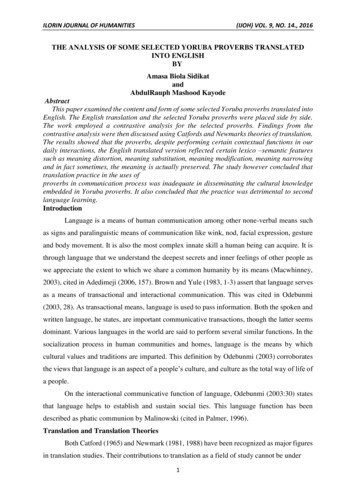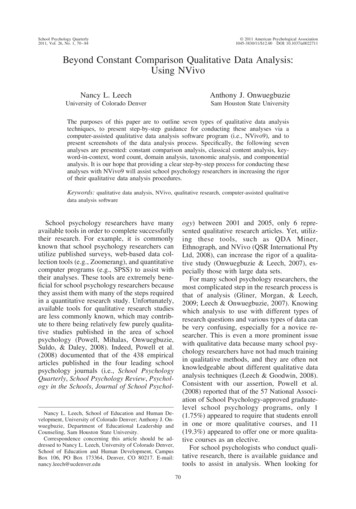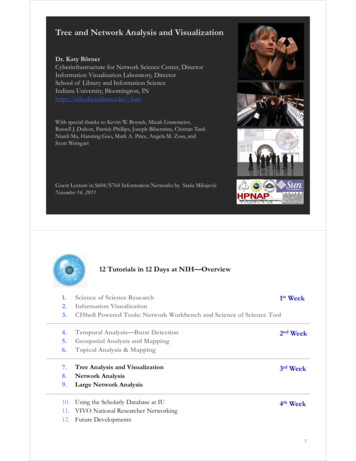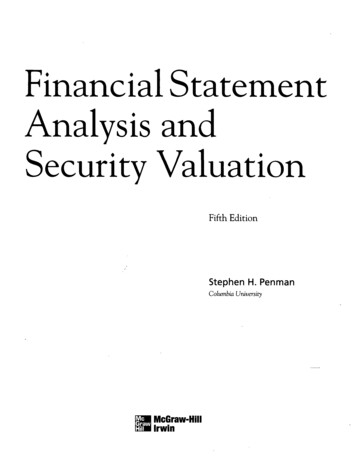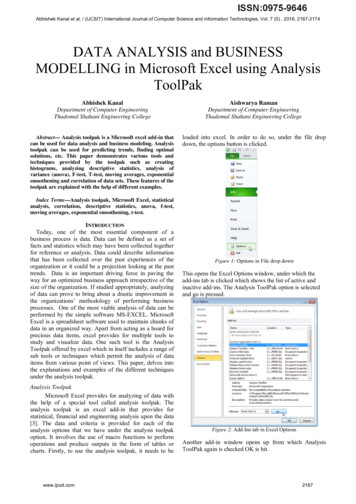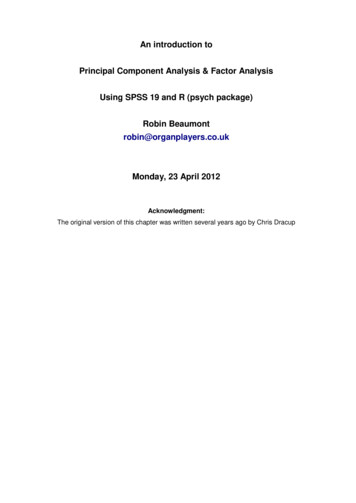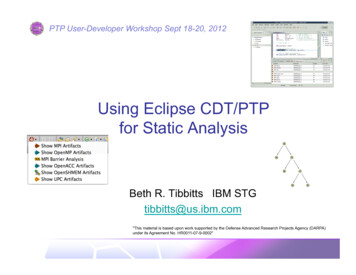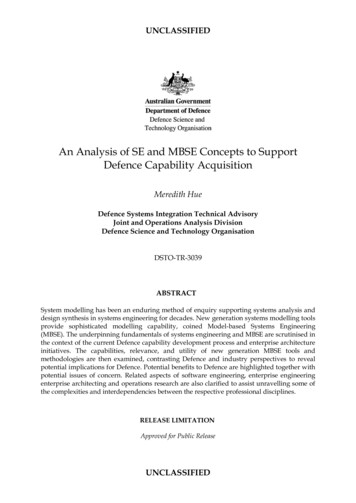
Transcription
UNCLASSIFIEDAn Analysis of SE and MBSE Concepts to SupportDefence Capability AcquisitionMeredith HueDefence Systems Integration Technical AdvisoryJoint and Operations Analysis DivisionDefence Science and Technology OrganisationDSTO-TR-3039ABSTRACTSystem modelling has been an enduring method of enquiry supporting systems analysis anddesign synthesis in systems engineering for decades. New generation systems modelling toolsprovide sophisticated modelling capability, coined Model-based Systems Engineering(MBSE). The underpinning fundamentals of systems engineering and MBSE are scrutinised inthe context of the current Defence capability development process and enterprise architectureinitiatives. The capabilities, relevance, and utility of new generation MBSE tools andmethodologies are then examined, contrasting Defence and industry perspectives to revealpotential implications for Defence. Potential benefits to Defence are highlighted together withpotential issues of concern. Related aspects of software engineering, enterprise engineeringenterprise architecting and operations research are also clarified to assist unravelling some ofthe complexities and interdependencies between the respective professional disciplines.RELEASE LIMITATIONApproved for Public ReleaseUNCLASSIFIED
UNCLASSIFIEDPublished byDefence Systems Integration Technical AdvisoryJoint and Operations Analysis DivisionDSTO Defence Science and Technology OrganisationPO Box 1500Edinburgh, South Australia 5111 AustraliaTelephone: 1300 333 362Fax: (08) 7389 6537 Commonwealth of Australia 2014AR- 016-126September 2014APPROVED FOR PUBLIC RELEASEUNCLASSIFIED
UNCLASSIFIEDAn Analysis of SE and MBSE Concepts to SupportDefence Capability AcquisitionExecutive SummaryModel-based systems engineering (MBSE) is proffered by modelling tool vendors toprovide improved ability to cope with the more onerous demands of engineering thelarger scale and more complex capability systems aspired to by Defence.The underpinning fundamentals of systems engineering and MBSE are scrutinised inthis report in the context of the current Defence capability development process andenterprise architecture initiatives. The capabilities, relevance, and utility of nextgeneration system modelling tools and methodologies are examined, contrastingDefence and industry perspectives to reveal potential implications for Defence.It is evident there are multiple overlapping MBSE perspectives, somewhat similar, butwith different problem foci and different problem solving approaches. If no commonagreement can be achieved, these differences in perspective can introduce considerableambiguity within the Defence stakeholder community; this can potentially exacerbaterather than resolve the problems at hand.MBSE tool vendors posit that MBSE methodologies can offer improved flexibility,consistency and traceability, and facilitate easier upgrade of the associated informationset. However, adoption of an effective MBSE approach by Defence would entail aDefence-wide methodological change to the capability development and acquisitionprocesses. This has the potential for significant and widespread impact, spanningcorporate management processes, engineering technical processes, governance and thetool environment within Defence. This change would have an inevitable impact onresourcing, staffing levels, staff skill-sets, training and support requirements.Analysis in this report has also revealed a major divide between Defence, as thecustomer, and industry as the supplier, in terms of mindsets, skill sets, scale ofendeavour, process requirements, constraints, and responsibilities. The methods ofenquiry and utility of MBSE tools for Defence and industry will therefore differmarkedly between the two mindsets and the differing responsibilities.The differing utility of systems engineering expertise as perceived by Defence andindustry is also a major differentiator. Due to the distributed responsibilities within theoverall Defence capability lifecycle, Defence does not have a unified systemsengineering approach, which has the potential to decouple the capability developmentprocess from the traditional systems engineering approach. This in turn introducesadditional challenges, and can negate other efforts towards achieving the desireddecision outcomes.Defence faces a number of challenges in developing and applying sufficient systemsengineering knowledge and experience both at the high-end platform and the Systemof Systems engineering levels to effect any major improvement to capability acquisitionUNCLASSIFIED
UNCLASSIFIEDoutcomes. The current approach to capability development does not explicitly definethe role of the systems engineer, instead, relying on process description in the DefenceCapability Development Handbook to drive the capability development andacquisition process. Process governance relies on extensive scrutiny by numerousstakeholders from many perspectives, however, there is no independent scrutiny froma systems engineering perspective to ensure the systems engineering precepts arepreserved.The need to undertake systems analysis is inherent but not explicitly acknowledgedwithin Defence. Of particular import, the capability development and acquisitionprocess is document-centric and governance-oriented. Early capability definitionactivities are centred on development of the documentation and satisfying governancerequirements rather than following a traditional systems engineering process.Finally, it is important to distinguish between the concept of a methodology that isfacilitated by a tool environment and the analytical capability of a tool modellingenvironment. Established MBSE methodologies such as the Rational Unified Processfor Systems Engineering (RUP SE) and the Object-Oriented Systems EngineeringMethodology (OOSEM) are modelling language dependent and implementationfocused, and thus may offer potential cost savings and efficiencies in industry.However, they do not address the problem space posed to Defence. These establishedmethodologies are therefore not necessarily suited for adoption in the Defence context.Notwithstanding, MBSE tools can provide a powerful analytic capability, particularlyto investigate capability and project interdependencies and propagation of capabilitysystem properties. This is contingent on the system models being set up correctly, usedby knowledgeable practitioners, and the results are used within the correct context.From a Defence enterprise architecture perspective, the new generation MBSE toolsprovide a useful means to create Defence Architecture Framework (DAF) artefactsusing templates. The MBSE tools are evolving to support future developments of theUK MODAF and US DoDAF towards a common Unified Architecture Framework,embracing data-centric system modelling concepts. The latest AUSDAF2 view-basedorientation does not provide a pathway towards supporting MBSE data-orientedconstructs, nor the Unified Architecture Framework.A separate study is recommended to investigate these issues further, including: The implications to Australian Defence capability development and acquisitionand Defence enterprise architecture initiatives of the Unified ArchitectureFramework proposed developments; The feasibility and selection criteria for different information elements forincorporation in an enterprise-wide repository, and associated knowledgemanagement process support requirements; and Provision of formal methodology guidance to leverage the potential of newgeneration MBSE tools to achieve improved Defence capability acquisition andintegration outcomes.UNCLASSIFIED
UNCLASSIFIEDAuthorMeredith HueDefence Systems Integration Technical AdvisoryJoint and Operations Analysis DivisionMeredith is responsible for providing advice on defence systemsintegration principles and practices targeting systemic problems inDefence, and working with projects to address specific systemintegration issues. A former Chief Engineer, she has over 35 yearsexperience in both industry and Defence as a Systems Engineeringpractitioner, in the areas of real-time systems, combat systems andmilitary communications. Specific interests include Systems,Systems of Systems, Enterprise Architecting and SystemsArchitecting methodologies supporting capability development,including modelling and analysis of C4ISR architectures.UNCLASSIFIED
UNCLASSIFIEDThis page is intentionally blankUNCLASSIFIED
UNCLASSIFIEDDSTO-TR-3039Contents1. INTRODUCTION . 11.1 Report Impetus . 11.2 Scope . 22. CONCEPTS OF METHODOLOGY AND THE SE DEVELOPMENTENVIRONMENT . 32.1 Significance of Methodology . 32.2 Significance of Scale . 53. SYSTEM MODELLING CONCEPTS. 83.1 Modelling Concepts in Engineering . 83.2 Modelling vs. Simulation . 93.3 What is a Model? . 103.3.1Real World Models . 103.3.2Conceptual Models . 113.3.3Decision Modelling . 143.3.4Information Model . 143.3.5Meta-modelling. 153.3.6Architecture Modelling . 163.3.7SW Architecture Modelling . 193.3.8Reference Models . 223.3.9Reference Architectures . 253.3.10Design Patterns . 253.3.10.1 Software Design Patterns . 253.3.10.2 SoS Design Patterns. 273.3.11Model Reuse . 283.4 Programming Language Concepts . 303.4.1Imperative Programming Language Paradigm . 303.4.2Object-Oriented Programming Language Paradigm . 303.5 Modelling Language Concepts. 323.5.1Language Concepts . 323.5.2Architecture Description Languages . 374. SYSTEMS APPROACH TO PROBLEM SOLVING . 454.1 Systems Analysis and Design Concept . 454.2 Structured Analysis and Design Paradigm . 474.2.1General Principles . 474.2.2Structured Analysis and Design Technique . 484.2.3Structured Systems Analysis and Design Method . 494.3 Object-Oriented Analysis and Design Paradigm . 504.4 Service-Oriented Analysis and Design Paradigm . 514.5 Service-Oriented Modelling and Architecture (SOMA) . 52UNCLASSIFIED
DSTO-TR-3039UNCLASSIFIED5. SYSTEMS ENGINEERING CONCEPTS . 545.1 What is Systems Thinking? . 545.2 What is a System? . 555.3 What is Systems Engineering? . 565.3.1Systems Engineering Origins and Purpose . 565.3.2Basic Notions of SE Process . 595.3.3Engineering Management Planning and Control Basics . 615.3.4Basic Activities and Responsibilities. 625.3.5Documentation in Systems Engineering . 675.3.6Formalisation of Systems Engineering as a Discipline. 675.3.7Contemporary Systems Engineering . 725.4 The Systems Engineering Process . 745.5 The System Life Cycle . 815.6 The Significance of System Architecture in SE . 845.7 Notions of System Hierarchy. 845.8 System of Interest and Systems of Systems. 885.9 Systems Integration and SoS Integration. 945.10 Human Systems Integration . 966. DEFENCE NOTIONS OF A SYSTEM . 986.1 The Capability System . 986.2 The Materiel System . 1006.3 Major Systems . 1006.4 Project vs. System Context . 1016.4.1Specification Considerations. 1016.4.2Life Cycle Considerations . 1026.5 Defence vs. INCOSE System Definition . 1027. CAPABILITY DEVELOPMENT PROCESS CONTEXT . 1037.1 Defence Capability Life Cycle Model. 1037.2 Defence Capability Planning Guidance . 1037.3 Defence Capability Life Cycle Responsibilities . 1038. DEFENCE VS. INDUSTRY SE PERSPECTIVE. 1088.1 Legal and Political Process Influences . 1088.2 Sourcing Defence Requirements . 1098.3 Sourcing Industry-based Requirements. 1138.4 Adaptability to Change. 1139. ENTERPRISE ARCHITECTURE CONCEPTS . 11810. DEFENCE ENTERPRISE ARCHITECTURE CONTEXT . 12110.1 Defence Architecture Framework . 12110.2 Integrated Defence Architecture . 12511. MBSE ORIGINS AND CONCEPTS. 131
.1011.11DSTO-TR-3039MBSE Impetus . 131MBSE Origins . 131MBSE Tool Capabilities . 133Model-Based Design . 138Model Driven System Design . 138Model Driven Engineering . 14211.6.1Graphical Modelling Techniques . 14211.6.2Rational Unified Process (RUP). 14211.6.3The RUP SE Process . 14811.6.4Object-Oriented Systems Engineering Methodology (OOSEM). 151Industry Impetus for MBSE . 153INCOSE Impetus for a New MBSE Approach . 154SE Perspective on New Generation MBSE Tool Environment . 156EAF Perspective on New Generation MBSE Tool Environment . 157Clarifying MBSE Perspectives . 15812. MINDSETS AND PERSPECTIVES. 16013. MBSE UTILITY TO DEFENCE . 16313.1 Utility Considerations . 16313.2 Defence Problem Space Considerations. 16313.3 MBSE Process Considerations. 16413.4 MBSE Tool Considerations – Analytic Capability . 16713.5 MBSE Tool Implications . 17613.6 MBSE Tool Considerations - Capability Development Process . 17713.7 MBSE Tool Considerations – AUSDAF . 17913.8 MBSE Tool Considerations - IDA . 18013.9 System Modelling Challenges . 18113.10 MBSE Possibilities for Defence . 18214. CONCLUSIONS. 18415. REFERENCES . 187APPENDIX A:TOOLS IN THE SE DEVELOPMENT ENVIRONMENT . 204A.1. Introduction. 204APPENDIX B:OBJECT-ORIENTED MODELLING LANGUAGE ORIGIN ANDCONCEPTS. 210B.1. Object-Oriented Programming Language Paradigm –Origin. 210B.2. Developing an Object-Oriented Architecture . 211B.3. Object-Oriented Modelling with UML. 212B.4. The 4 1 Architecture View using UML2 . 213B.5. Systems Modelling Language (SysML) – Origins . 216B.6. Systems Modelling Language (SysML) – Concepts . 219UNCLASSIFIED
DSTO-TR-3039UNCLASSIFIEDAPPENDIX C:UML AND SYSML COMMON TERMS AND DIAGRAMS . 221C.1. Object-Oriented Problem Solving – Overview . 221C.2. Important Terms and Concepts . 221C.3. Tool User Interface . 223C.4. UML Diagrams . 226C.4.1UML2 Object and Class and Diagrams. 226C.4.2UML2 Package Diagram . 227C.4.3UML2 State Chart and Activity Diagram . 228C.4.4UML2 Sequence Diagram . 230C.4.5UML2 Communication Diagram . 231C.4.6UML2 Timing Diagram. 232C.4.7UML2 Interaction Overview Diagram . 233C.4.8UML2 Component Diagram . 234C.4.9UML2 Deployment Diagram . 235C.4.10 UML2 Composite Structure Diagram . 236C.4.11 UML2 Use Case Diagrams. 237C.5. SysML Diagrams . 237C.5.1SysML System Block Definition Diagram . 237C.5.2SysML Requirements Diagram . 239C.5.3SysML Package Diagram . 240C.5.4SysML Internal Block Diagram . 241C.5.5SysML Parametric Diagram . 242C.5.6SysML Use Case Diagrams . 243APPENDIX D:ZACHMAN FRAMEWORK FOR ENTERPRISEARCHITECTURE OVERVIEW . 244D.1. Introduction. 244D.2. Zachman Framework Reference Model . 244APPENDIX E:RATIONAL UNIFIED PROCESS FOR SYSTEMSENGINEERING (RUP SE) OVERVIEW . 250E.1. Introduction. 250E.2. RUP SE Representations . 250APPENDIX F:UML TOOL SUPPORT FOR DODAF . 254
UNCLASSIFIEDDSTO-TR-3039Abbreviations and KBPMNBRMC4ISR lian Defence ForceAir Defence Ground EnvironmentArchitecture Description LanguageArchitecture Development MethodAustralian Government ArchitectureAustralian Government Information Management OfficeAmerican National Standards InstituteApplication Program InterfaceArchitecture Review MeetingAutomatic Teller MachineAustralian Defence Architecture Framework (also known as DAF)Body of KnowledgeBusiness Process Modelling NotationBusiness Reference ModelCommand, Control, Communications, Computing, Intelligence,Surveillance and Reconnaissance Architecture FrameworkComputer-aided DesignCore Architecture Data ModelComputer-aided EngineeringComputer-aided Software EngineeringCircuit Card AssemblyCapability Development DocumentationCapability Development GroupContract Data Requirements ListConfiguration ItemChief Information Officer GroupCommon Operating EnvironmentCommon Object Request Broker ArchitectureCommercial-off-the-ShelfDefence Architecture Framework (also known as AUSDAF)Defence Capability Development HandbookDefence Capability GuideDefence Capability PlanData Flow DiagramDoDAF Meta-ModelDefence Materiel OrganisationDepartment of National Defence, CanadaDepartment of National Defence Architecture Framework(Canada)Department of Defense Architecture Framework (U.S.)Data Reference ModelEnterprise ArchitectureEnterprise Architecture FrameworkElectronic Components Industry AssociationUNCLASSIFIED
IISNIFOCDOMGOMTO-OUNCLASSIFIEDFor exampleElectronic Industries Alliance (known as Electronic IndustriesAssociation prior to 1997)Electromagnetic CompatibilityElectromagnetic InterferenceFederal Enterprise ArchitectureFederal Enterprise Architecture Framework (U.S.)Fundamental Inputs to CapabilityField Programmable Gate ArrayFunction and Performance SpecificationForce Structure ReviewGartner Enterprise ArchitectureGlobal Information GridHuman Systems IntegrationHardwareInformation and Communications TechnologyIntegrated Defence ArchitectureThat isInternational Electro-technical CommissionInstitute of Electrical and Electronic EngineeringInternational Council on Systems EngineeringIntegrated Product and Project DevelopmentIntegrated Project TeamInternational Standards OrganisationIntelligence, Surveillance and ReconnaissanceInformation TechnologyJoint Capabilities Integration Development SystemMODAF Meta-ModelModel-Based Systems EngineeringModel-driven ArchitectureModel-driven DesignModel-driven EngineeringModel-driven System DesignMinistry of Defence Architecture Framework (UK)Military Off-the-ShelfNATO Architecture FrameworkNorth Atlantic Treaty OrganisationNetwork Centric Operations Industry ConsortiumNational Council on Systems Engineering (in the US)Network Centric WarfareNetwork Centric Warfare Integration and ImplementationStrategyNCOIC Interoperability FrameworkOperational Concept DocumentObject Management GroupObject Modeling TechniqueObject-Oriented
KUK MODUMLUPDMU.S.US DoDVACRMVOAObject-Oriented AnalysisObject-Oriented Analysis and DesignObject-Oriented DesignObject-Oriented Software EngineeringObject-Oriented Systems Engineering MethodologyOperations ResearchOperational Test and EvaluationOff-the-ShelfPrinted Circuit BoardProgram of Major Service ActivitiesProcess Methods Tools EnvironmentPerformance Reference ModelRequest for TenderRational Unified ProcessStructured Analysis and Design TechniqueSystem Description LanguageSystems EngineeringSystems Engineering Society of AustraliaSystems Engineering Test & Evaluation SymposiumSystems IntegrationSingle Information EnvironmentService-oriented ArchitectureService-oriented Analysis and DesignService-Oriented Modelling and ArchitectureStandard Operating ProcedureSystem of SystemsSystem of Systems EngineeringSystem of Systems IntegrationSpecificationsService Reference ModelStructured Systems Analysis and Design MethodStandard for the Exchange of Product model dataSoftwareSystem Modelling LanguageTest Concept DocumentThe Open Group Architecture FrameworkTechnical Reference ModelUnited Architecture FrameworkUltra High FrequencyUnited KingdomUnited Kingdom Ministry of DefenceUnified Modelling LanguageUnified Profile for DoDAF and MODAFUnited States of AmericaUnited States Department of DefenseVerification Assurance Cross-Reference MatrixVariability-oriented AnalysisUNCLASSIFIEDDSTO-TR-3039
DSTO-TR-3039V&VWBSXMIXMLZFUNCLASSIFIEDVerification and ValidationWork Breakdown StructureXML Metadata InterchangeExtensible Markup LanguageZachman Framework for Enterprise Architecture
UNCLASSIFIEDDSTO-TR-30391. Introduction1.1 Report ImpetusPioneered by the Defence and Aerospace sectors in the 1940s, Systems Engineering (SE)practice has evolved significantly in recent decades as systems engineers have bothenthusiastically progressed the development of new computer-based technology, thenembraced this new technology to enhance their own SE development environments.Despite these changes, systems modelling has remained an enduring method of enquirysupporting systems analysis and design synthesis in SE. New generation system modellingtools seek to extend the SE development environment even further by providing a moresophisticated systems modelling capability, coined MBSE (model-based systemsengineering) in its most recent form, suggesting that another paradigm shift in SE might bein the offing.From a Defence perspective, in recent years, capability development and acquisitionprocesses have strained to cope with the increasing scale, complexity, and interdependencyof capability as Defence has embraced the onset of the information age and adopted newconcepts of networked warfare. MBSE is proffered by modelling tool vendors to provideimproved ability to cope with the more onerous demands of engineering the larger scaleand more complex systems as aspired in Defence.To improve system integration outcomes, it is important to understand what is so difficultabout systems engineering and Defence capability development. An inherent challenge ofdeveloping integrated systems that involve multiple technical disciplines is that eachprofessional may be an expert in their respective field, but they will no
requirements rather than following a traditional systems engineering process. Finally, it is important to distinguish between the concept of a methodology is that facilitated by a tool environment and the analytical capability of a tool modelling environment. Established MBSE methodologies such as the Rational Unified Process
